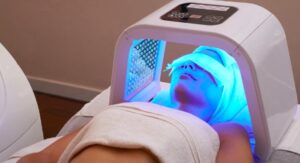Do you have dark brown, light brown, blue-grey, or dark brown spots on your skin? LED phototherapy is widely used today in the treatment of hyperpigmentation disorders such as melasma. Over the past five years, LED therapy has become very common. But the biggest question is, does LED phototherapy work?
LED phototherapy isn’t a new concept and dermatologists have been using it for the past 30 years. Recently, there has been an increase in the amount of LED devices both in clinics and stores. Today you can buy things like LED wands, LED masks, and applicators for at-home use at any time.
With the recent onset of technology, LED devices for melasma management are now made cheaply. This means they can now be easily incorporated as an at-home treatment for various skin conditions such as acne, melasma, skin rejuvenation, and photoaging. These devices are also good for the treatment of cosmetic concerns such as lines, wrinkles, and pores.
Today we’ll discuss LED phototherapy in managing melasma and other skin pigment disorders.
Table of Contents:
- Part 1: What is LED Phototherapy
- Part 2: How Does LED Phototherapy Work?
- Part 3: Do Dermatologists Use Photobiomodulation?
What is LED Phototherapy
 LED phototherapy is a form of low laser therapy. LED is the short form for light-emitting diodes. For skin therapy requiring low light therapy, the LED name has been reduced to low-level laser therapy (LLLP). There are three different types of LEDs. The commonly prescribed LEDs are red, blue, and yellow wavelengths. Some are gentle and safe while others are unsafe for the treatment of Melasma.
LED phototherapy is a form of low laser therapy. LED is the short form for light-emitting diodes. For skin therapy requiring low light therapy, the LED name has been reduced to low-level laser therapy (LLLP). There are three different types of LEDs. The commonly prescribed LEDs are red, blue, and yellow wavelengths. Some are gentle and safe while others are unsafe for the treatment of Melasma.
Melasma is a prevalent skin condition that affects women more than men and presents a stubborn pigmentation. It’s caused by three things; genetics, hormonal factors, and radiation. The radiation factor varies between UVB, UVA, visible light, and infrared light.
Now, how does LED phototherapy treat melasma? LED devices produce only one wavelength of light. Simply put, one LED device has one light bolt which produces one wavelength. The simple blue wavelength light has a frequency as low as 420 nm while the red wavelength light has a frequency of around 630 nm. Other wavelengths such as yellow, orange, and ERS have a frequency of around 830 nm.
In the context of treating melasma, you should always avoid blue light. Blue light is very useful for the treatment of acne because it kills the bacteria which is found in pimples, cysts, and pores. Particularly because the bacteria is very sensitive to blue light. The blue light exhibits antimicrobial activity which produces a reactive oxygen species that kills components of bacterial cells and thus help with acne lesions.

The problem with using blue light in the treatment of melasma is that it stimulates pigment cells. In other words, blue light stimulates melanocytes which produce melanin which worsens melasma. This is more prevalent in patients of skin color or patients with darker skin types.
Asians, Hispanic patients, and the like have a receptor in their melanocyte which is very prone to blue light activation. This leaves you with the option of two light spectrums or wavelengths which are 630 nm and 830 nm.
Most at-home kits from companies such as Ominlux LED and Dr. Dennis Gross have LED phototherapy devices that produce light wavelengths of around 630 – 633 nm and 830 nm. This wavelength range offers a safe action spectrum for melasma treatment.
How Does LED Phototherapy Work?
 The process of treating melasma using LED phototherapy is called photobiomodulation (PBM). Photobiomodulation is basically the wavelength of light that gets delivered to your skin and it causes biomedical reactions in the skin that alter the state of the skin itself. This is different from lasers that work under a basis called selective photothermolysis.
The process of treating melasma using LED phototherapy is called photobiomodulation (PBM). Photobiomodulation is basically the wavelength of light that gets delivered to your skin and it causes biomedical reactions in the skin that alter the state of the skin itself. This is different from lasers that work under a basis called selective photothermolysis.
Lasers target a pigment in the skin for example the melanin or blood vessels which have been implicated with the melasma formation. The spectrum causes an immediate reaction that’s targeted. In contrast, photobiomodulation creates a pathway that’s not specific.
In the case of LED phototherapy, it modulates gene expression. In other words, the genes produce pigment so it can modulate the enzyme called tyrosinase which gives pigmentation. Melasma patients usually have a disorder of the blood vessels. LED therapy helps modify the amount of blood vessels and the amount of inflammation in the skin.

Again, LED phototherapy helps treat melasma by increasing the transcription of genes that repair the basement membrane. This is the layer that separates your epidermis from the dermis. When Blue LED phototherapy repairs the basement membrane, the skin becomes stronger and there are lesser chances of the melanocytes dropping out into the dermis.
Photobiomodulation modulates the inflammatory cells which have been implicated in melasma. These cells include Mast cells which release histamine. This means the light modulates the cross-talking between cells which include the fibroblasts which produce collagen and Mast cells which produce histamine.
Do Dermatologists Use Photobiomodulation?
 Dermatologists do not use photobiomodulation and it’s not because it doesn’t work. When looking at other alternative medical therapies for pigment correction like Pico lasers and Novel Skin Peels, they work a lot better compared to using LED phototherapy.
Dermatologists do not use photobiomodulation and it’s not because it doesn’t work. When looking at other alternative medical therapies for pigment correction like Pico lasers and Novel Skin Peels, they work a lot better compared to using LED phototherapy.
The other flipside when using LED treatment for melasma, the dose has to be exact. When you use a high-powered LED, the spectrum worsens melasma. This is because it stimulates pigmentation. Using LED devices that produce an infrared spectrum causes the generation of heat which further worsens melasma.
The therapeutic window for LED phototherapy is very narrow when it comes to melasma treatment. This doesn’t mean you shouldn’t use LED light therapy devices. Be selective, read the device features keenly, and use the device according to the instructions.
Nevertheless, LED phototherapy is used by dermatologists when healing the skin after laser treatment.
Conclusion
If you want to use LED phototherapy for at-home treatment, buy your device from a reputable brand, and use LED devices that produce a wavelength frequency of 630 nm or augment that with an 830 nm device. Avoid blue LED phototherapy when treating melasma and use the best pigment correctors.
When buying an LED light phototherapy device for melasma treatment, you should consider the device’s wavelength frequency, the device’s efficiency in delivering the light spectrum, and the irradiance.

 By myulikeadmin
By myulikeadmin



